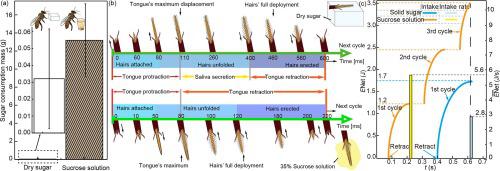当前位置:
X-MOL 学术
›
J. Insect Physiol.
›
论文详情
Our official English website, www.x-mol.net, welcomes your
feedback! (Note: you will need to create a separate account there.)
Feeding behavior of honey bees on dry sugar.
Journal of Insect Physiology ( IF 2.3 ) Pub Date : 2020-05-21 , DOI: 10.1016/j.jinsphys.2020.104059 Caiying Liao 1 , Yuejun Xu 1 , Yu Sun 1 , Matthew S Lehnert 2 , Wuweikai Xiang 3 , Jianing Wu 1 , Zhigang Wu 1
Journal of Insect Physiology ( IF 2.3 ) Pub Date : 2020-05-21 , DOI: 10.1016/j.jinsphys.2020.104059 Caiying Liao 1 , Yuejun Xu 1 , Yu Sun 1 , Matthew S Lehnert 2 , Wuweikai Xiang 3 , Jianing Wu 1 , Zhigang Wu 1
Affiliation

|
The feeding habits of insects can be influenced by food abundance, nutrition, physical forces, and many other variables, which is why this topic is multidisciplinary and perennially fascinating. Although honey bees primarily feed on liquid nectar, they also can feed on dry sugar; however, the feeding mechanism for feeding on dry substances by a primarily fluid-feeding insect remains unexplored. We observed that, when honey bees are accessible to both dry sugar and liquid nectar, they prefer to feed on the latter. To elucidate the diet preference, we conducted a comparative study between feeding on dry-sugar and drawing up liquid-nectar, from the tongue kinematics and dynamic configuration, friction force, glossal durability, and feeding efficiency. Using a high-speed camera, we discovered that the hairy tongue of the honey bee uses back-and-forth movements to furrow a groove on pieces of dry sugar, with saliva simultaneously dissolving the sugar. We found that the lapping frequency of the tongue on dry sugar reduces from 4.5 Hz to 1.6 Hz when compared to feeding on the liquid diet; a 64% decrease in average tongue speed. Through tribological tests, we revealed that the friction forces when feeding on dry sugar is approximately 5 times that of dipping nectar, and the glossal hairs wear 4 times faster when feeding on dry sugar compared to the sucrose solution. We built a mathematical model to bridge the gap between energy intake rate and tongue dynamics of these two feeding modes. The theoretical net energy intake rate of feeding on dry sugar is 50% lower than when feeding on sucrose solutions. Both experimental and theoretical discoveries revealed that although honey bees can feed on dry substances, natural selection has forged their tongue structures primarily for a liquid diet. This study combined behavioral and mechanical tests with mathematical modeling, which highlights the advantages of using multidisciplinary approaches for uncovering the feeding physiology of insects.
中文翻译:

蜜蜂对干糖的摄食行为。
昆虫的摄食习惯可能受到食物丰度,营养,身体力量和许多其他变量的影响,这就是为什么该主题是多学科的,并且常年吸引人。尽管蜜蜂主要以液态花蜜为食,但它们也可以以干糖为食。然而,对于主要由液体喂养的昆虫来饲喂干燥物质的饲喂机制仍未探索。我们观察到,当干糖和液态花蜜都可以接近蜜蜂时,他们更喜欢以后者为食。为了阐明饮食习惯,我们从舌头运动学和动态构型,摩擦力,光泽持久性和进食效率进行了一项比较研究,以干糖为食,并以液态糖为食。使用高速相机 我们发现蜜蜂的毛茸茸的舌头通过来回运动在干糖片上开槽,唾液同时溶解了糖。我们发现,与以流质饮食为食相比,干糖对舌头的舔frequency频率从4.5 Hz降低到1.6 Hz。平均舌头速度降低64%。通过摩擦学测试,我们发现,以蔗糖溶液为食时,以干糖为食时的摩擦力约为浸入花蜜的摩擦力的5倍,以毛糖为食时,光泽毛的磨损速度要快4倍。我们建立了一个数学模型来弥合这两种喂养方式的能量摄入率和舌动力之间的差距。以干糖为食的理论净能量摄入率比以蔗糖溶液为食的理论净能量摄入率低50%。实验和理论上的发现都表明,尽管蜜蜂可以以干物质为食,但自然选择主要是为了流质饮食而锻造了它们的舌头结构。这项研究将行为和力学测试与数学建模相结合,突出了使用多学科方法揭示昆虫的摄食生理的优势。
更新日期:2020-05-21
中文翻译:

蜜蜂对干糖的摄食行为。
昆虫的摄食习惯可能受到食物丰度,营养,身体力量和许多其他变量的影响,这就是为什么该主题是多学科的,并且常年吸引人。尽管蜜蜂主要以液态花蜜为食,但它们也可以以干糖为食。然而,对于主要由液体喂养的昆虫来饲喂干燥物质的饲喂机制仍未探索。我们观察到,当干糖和液态花蜜都可以接近蜜蜂时,他们更喜欢以后者为食。为了阐明饮食习惯,我们从舌头运动学和动态构型,摩擦力,光泽持久性和进食效率进行了一项比较研究,以干糖为食,并以液态糖为食。使用高速相机 我们发现蜜蜂的毛茸茸的舌头通过来回运动在干糖片上开槽,唾液同时溶解了糖。我们发现,与以流质饮食为食相比,干糖对舌头的舔frequency频率从4.5 Hz降低到1.6 Hz。平均舌头速度降低64%。通过摩擦学测试,我们发现,以蔗糖溶液为食时,以干糖为食时的摩擦力约为浸入花蜜的摩擦力的5倍,以毛糖为食时,光泽毛的磨损速度要快4倍。我们建立了一个数学模型来弥合这两种喂养方式的能量摄入率和舌动力之间的差距。以干糖为食的理论净能量摄入率比以蔗糖溶液为食的理论净能量摄入率低50%。实验和理论上的发现都表明,尽管蜜蜂可以以干物质为食,但自然选择主要是为了流质饮食而锻造了它们的舌头结构。这项研究将行为和力学测试与数学建模相结合,突出了使用多学科方法揭示昆虫的摄食生理的优势。











































 京公网安备 11010802027423号
京公网安备 11010802027423号